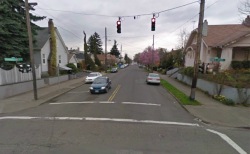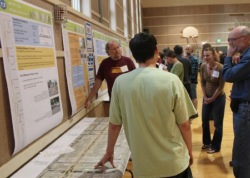
final open house.
(Photo: PBOT)
The Portland Bureau of Transportation (PBOT) is just weeks away from asking City Council to formally adopt their final design recommendation for the 50s Bikeway Project. The $1.5 million federally funded project, which was first identified as a priority 15 years ago in the 1996 Bike Master Plan, will improve bicycling conditions on a five mile section of 52nd and 53rd streets between the Woodstock and Hollywood neighborhoods.
“The plan will be a big help in creating connectivity between the neighborhoods in this part of town.”
— John Mulvey, CAC member
On June 29th, PBOT hosted the second and final open house for the project. 120 people showed up to see the City’s final plans, capping a robust public outreach process that began last summer.
As I reported last month, the project will be a combination of shared roadway treatments and bike lanes.
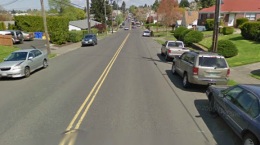
lanes were more important that
on-street parking.
In the northern part of the route, which is residential and has low-traffic volume, PBOT will install sharrows, new signage, curb extensions, new crossing treatments, and will flip stop signs to prioritize bike travel. In the southern part of the route (south of Division to Woodstock), PBOT will remove 202 parking spots on the east side of the street to make room for six-foot wide bike lanes in both directions.
Unlike the debates that have stalled other bike projects PBOT is currently working on, their 50s Bikeway plan earned the endorsement of all 10 neighborhood associations it passes through and is being praised by citizen activists and nearby residents as well.
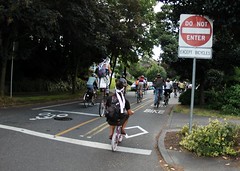
on SE Clinton Street, raised concerns
from some residents.
(Photo © J. Maus)
One major sticking point in the project was the proposed use of diverters at Burnside (at 53rd) and Division (at 52nd). PBOT wants to restrict motor vehicle access onto the bikeway route from these busy arterials, and diverters (which restrict car access, but allow bicycles through) are the most effective way to do it. However, neighbors fear that the traffic will simply shift over to adjacent streets.
The Mount Tabor Neighborhood Association was the loudest critic of these diverters. They were the only neighborhood to formally vote against PBOT’s proposal to install them.
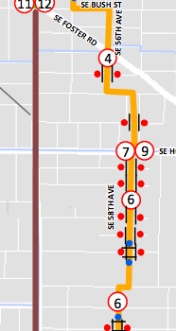
been identified, but not funded
in the current plan.
To quell concerns about traffic diversion, PBOT decided to move forward with a six-month “test.” During that time, they will analyze the impacts and conduct more public involvement before making the access restrictions permanent.
Another point of concern with this project is the southern section. Some stakeholders think the bike lanes and signage won’t be enough to create a low-stress bicycling environment. An alternate route that weaves through adjacent side streets was identified in the final plan, but PBOT won’t allocate the money to build it yet.
Citizen’s Advisory Committee member John Mulvey says that, while he would have liked to see even more protection for bike traffic at high-traffic intersections, he’s thrilled with the project overall.
“The plan will be a big help in creating connectivity between the neighborhoods in this part of town,” he told me via email. Mulvey says the new bikeway will be a major help in crossing “barriers” like SE Powell Blvd and Sandy.
As far as how the plan ended up, Mulvey says he, “Would have liked to see stronger protection for bikers and pedestrians at the places with the most auto traffic, like the corner of Foster and 52nd. Bikers in that area need more help than they’re getting.” But, he adds, the 50s Bikeway plan is “pretty ambitious as it is.”
Doug Klotz, a Richmond neighborhood resident and member of the City of Portland Pedestrian Advisory Committee, says he was encouraged that parking removal in the project was well-supported by both neighborhood and business associations. “It seems like the importance of good bike facilities has become clear to a great many Portlanders.”
In addition to what he calls a “smart mix of bike lanes and [bike] boulevard treatments,” Klotz says people who walk in these neighborhoods will also benefit. “Pedestrians will benefit, not just from the new signals at 53rd and Burnside and 54th and Powell, but also from the traffic slowing and volume reduction on 52nd and other streets.”
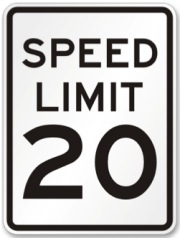
mph law for this project.
On the issue of traffic speeds, PBOT plans to utilize a new state law for this project that gives them the authority to lower speed limits on residential streets to 20 mph.
As I’ve tracked this project, one other thing has become clear. The PBOT project managers behind this public process — Rich Newlands, Sarah Figliozzi and Jennie Tower — have been widely praised for their work. “They did a great job and showed more patience than I would have,” said Mulvey.
The Foster-Powell Neighborhood, in a letter of support for the project, also called out PBOT staff.
“We also would like to express our appreciation for the work of the project team at PBOT,” they wrote, “This planning process involved reaching consensus on several delicate issues, a task they accomplished with great professionalism and sensitivity.”
Figliozzi says they hope to bring their final plan to City Council in mid-August. Construction of the project is slated for next summer. Read our past coverage at the 50s Bikeway story tag.
